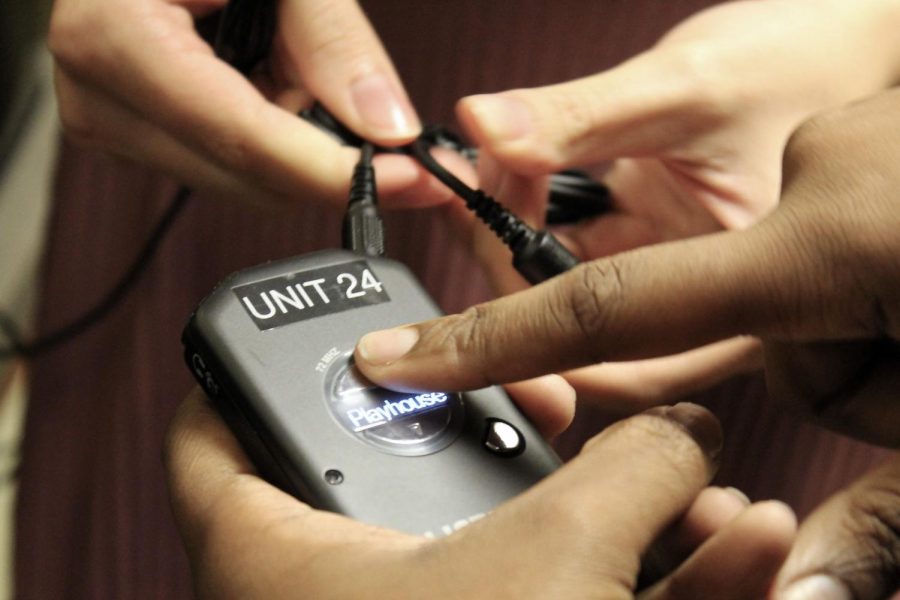Krannert device to aid hearing
Krannert Center for the Performing Arts introduced new assisted-listening devices for patrons who are hard of hearing.
Oct 15, 2018
Krannert Center for the Performing Arts has implemented a new listening system, in hopes of making performances more accessible to people who are hard of hearing.
For over three and a half years, Alec LaBau, Krannert Center’s assistant audio director, and his team have worked to replace an outdated assisted listening system.
“Many of the old theaters had an infrared system, which meant you had to have a line of sight, keep the transmitter outside of your clothing and point it in a certain direction for it to work,” LaBau said.
The infrared system had to be reconfigured for every show, which made for an inconsistent listening experience for patrons with hearing loss, as even the slightest movement could cut-off transmission.
There was also the challenge of matching the frequency on the old infrared device to the correct theater, as each performance space had a different sound setup.
Get The Daily Illini in your inbox!
“They were different in every theater, but we wanted a unified system across the building. Now it doesn’t even matter what transmitter you have,” LaBau said.
The devices at Krannert now work similarly to a handheld radio or car stereo, with an FM signal from microphones set-up in every theater, able to transmit to listeners in any direction through clothing, allowing for a more discreet use of the device that doesn’t draw attention to patrons’ disabilities.
“You can put it in your pocket, it doesn’t have to stay present. That way, you can be a little more discreet with it,” LaBau said.
The new device is also able to be used on its own with a patron’s headphones or can be connected to a loop system, where a special loop compatible with most hearing aids can be connected to the device and worn around the neck.
For Molly Smith, freshman in FAA, the importance of sound in performance, whether in a contemplative play or raucous musical, doesn’t go unnoticed.
“There’s so much you can do with sound. There are even plays that involve simple drum beats stopping and starting to represent different things in the show,” Smith said. “It’s so important to making sure that not only what the actors are saying, but the intention of the show gets across.”
Upon hearing about the new device providing accessibility to more theatre-goers, Smith’s eyes lit up instantaneously.
“It’s amazing. It’s leveling the playing field for people who haven’t had the chance to come before,” she said.
This new step toward greater accessibility is especially valuable to students like Jose Chavez, freshman in LAS, who has hearing loss in his right ear. Performances at Krannert without listening aids could lead to missed information and overall enjoyment for Chavez.
“If someone says something a little too low or on the wrong side of my face, it’s easy to get lost,” Chavez said.
Spaces like Krannert have had certain disadvantages for accessible hearing, due to their unique designs that treasure natural acoustics without the nuisance of microphones and speakers.
“Krannert was designed and built so that you can hear words from the stage in the back of the auditorium without microphones,” Smith said. “Of course, this becomes a lot harder if you’re hard of hearing.”
This disadvantage for certain patrons could also lead to unexpected and unfair expenses, Smith said.
“If you’re hard of hearing, you might have to pay more money to get up front because you can’t hear from farther away,” she said.
Smith said the system gives patrons with hearing loss more freedom when choosing where to sit.
“Erasing that economic burden for people who just want to come and enjoy good, professional theatre in a local setting on campus is amazing,” Smith said.
With the new system in place, Chavez emphasized both the audience and Krannert Center itself will benefit on many levels by providing greater accessibility.
“I feel like this opens up the audience to a lot more people who otherwise wouldn’t be able to understand it,” Chaves said. “This now gives them the opportunity to be there and enjoy it in the way everybody else can.”






